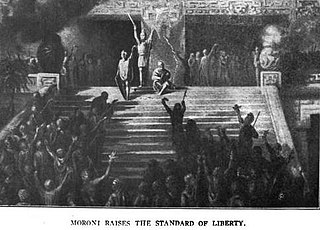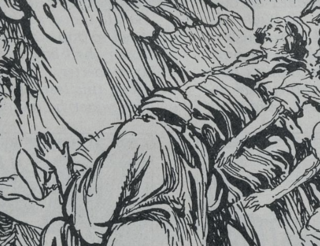
The Book of Alma: The Son of Alma, usually referred to as the Book of Alma, is one of the books that make up the Book of Mormon. The title refers to Alma the Younger, a prophet and "chief judge" of the Nephites. Alma is the longest book in the Book of Mormon and consists of sixty-three chapters, taking up almost a third of the volume.
The Book of Enos is the fourth book in the Book of Mormon and is a portion of the small plates of Nephi. According to the text it was written by Enos, a Nephite prophet.
The Book of Jarom is the fifth book in the Book of Mormon. According to the text it was written by Jarom, who was the son of Enos and a descendant of Jacob, the brother of the prophet Nephi.
The Book of Omni is one of the books that make up the Book of Mormon, a text that the Latter Day Saint movement regards as scripture. The book is written as the combined composition of several authors, the first of whom, Omni, provides the name of the book. According to the narrative, the book covers more than two centuries of Nephite history within one chapter of text. It refers to wars between the Nephites and Lamanites, the reign of Kings Mosiah and Benjamin, and their participation in the wars and journeys through the wilderness.
The Words of Mormon is one of the books that make up the Book of Mormon, a text that is held sacred in the Latter Day Saint movement. It consists of a single chapter of eighteen verses and is the only book in the text which is not titled as a "book." According to the text, it is a comment inserted by the prophet Mormon while compiling the records which became the Book of Mormon.

Nephi is one of the central figures described in the Book of Mormon. In the Church of Jesus Christ of Latter-day Saints, he is described as the son of Lehi, a prophet, and the founder of the Nephite people. The Book of Mormon also describes him as the author of its first two books, First and Second Nephi.

King Noah is a Nephite king in the Book of Mormon who appears in the Book of Mosiah. Noah rules over a Native American colony which came from Zarahemla and settled in the land of Lehi-Nephi, succeeding his father, Zeniff. In the Book of Mosiah, King Noah breaks away from his father's teachings, committing "all manner of wickedness." Noah and his priests sentence the prophet Abinadi, who prophesied of his kingdom's downfall if they did not repent, to death by fire. During a Lamanite invasion, Noah and some of his people flee the land, and those who remain are subjected to Lamanite control. Noah attempts to forbid his men from returning to their families, and they burn him at the stake. Noah is succeeded by his son, Limhi.

In the Book of Mormon, Alma, the son of Alma is a Nephite prophet often referred to as Alma the Younger to distinguish him from his father, who is often referred to as Alma the Elder. These appellations, "the Younger" and "the Elder," are not used in the Book of Mormon; they are distinctions made by scholars, useful because both individuals were prominent during the same time period in the Book of Mormon's story and filled a similar cultural and religious role. Alma is the namesake of the Book of Alma.

In the Book of Mormon, Lamoni is king of the land of Ishmael, part of territory controlled by the Lamanites. Lamoni's father is king over all of the Lamanites. After initially having the Nephite missionary Ammon imprisoned, Lamoni later allows him to be his servant. After Ammon saves some of Lamoni's servants and animals in a seemingly miraculous way. Lamoni then believes that Ammon is the Great Spirit, but learns that he is only a servant of the Great Spirit, or God. After his conversion, Lamoni is traveling with Ammon when he encounters his father. At the peril of his life Lamoni defends Ammon. Eventually Lamoni helps gain freedom for Ammon and his fellow Nephite missionaries to preach freely in the Lamanite areas.

Ammonihah is a city mentioned in the Book of Mormon described as governed by lawyers and judges. When the Book of Mormon prophet Alma visits Ammonihah as part of a preaching tour, the city becomes the setting of "one of the most disturbing episodes" of the text in which Ammonihah's governing elite imprison him, exile any men converted by his preaching, and kill women and children associated with his mission by fire.

According to the Book of Mormon, Ammoron was a Nephite traitor. A descendant of Zoram, he succeeded his brother Amalickiah as the king of the Lamanites. Amalickiah, as king, started a major war with the Nephites, which the Nephites had hoped would end with his death. However, Ammoron seized power and continued the war. Eventually his armies were defeated after he was assassinated by Teancum.

Nehor is the founder of an apostate sect mentioned in the Book of Mormon around 90 BC in the first year of the reign of the judges. He teaches the Nephites that priests and teachers should be supported by their followers, and that all will be saved in the end. Nehor is brought before Alma the Younger for killing Gideon, a Nephite elder who argued with him. Alma accuses him of priestcraft and sentences him to death for enforcing his beliefs with violence. When executed, Nehor admits to teaching against the word of God.

In the Book of Mormon, Amalickiah was a Nephite dissenter. His first appearance in the text is as a political dissident with aspirations to re-establish a monarchy. Later, after seizing the Lamanite throne, Amalickiah led a war to enslave the Nephites. After his death he was succeeded by his brother Ammoron. The story appears in the latter half of the Book of Alma.

The Amalekites, in the Book of Mormon, are a group of Native American dissenters from the Nephites around 90 B.C. They are after the order of Nehor and therefore believe that there will not be a Messiah and repentance is unnecessary, so when Nephite missionaries come preach to them, only one Amalekite coverts. They also press the Lamanites to war against the Nephites multiple times and participate in the destruction of Ammonihah.

According to the Book of Mormon, the Amlicites were a break-off group of Nephites in the Book of Alma, around 87 B.C. Their leader, Amlici, is not chosen by the people as king, so he and the Amlicites leave the Nephites and join the Lamanites. The Nephites win both of their battles with the Amlicites and Alma kills Amlici in the second battle.

Aminadab is a person in the Book of Mormon who appears in the Book of Helaman. He had been a member of the Nephite church but left it and became associated with the Lamanites. In the Book of Helaman, after Nephi abdicates the Chief Judgment Seat to Cezoram, he and his brother Lehi go to preach to the Lamanites, who imprison them. After a heavenly incident, Aminadab clarifies to the surrounding Lamanite captors that Nephi and Lehi are conversing with angels.

Abish is a figure in the Book of Mormon who plays a pivotal role in a missionary narrative. She is one of only three named women unique to the Book of Mormon.

The following outline is provided as an overview of and topical guide to the Book of Mormon:

The Book of Mormon monetary system is part of the setting of the Book of Mormon. It is the system of economic exchange used by the narrative's Nephites. Mormon, the internal narrator of the Book of Mormon, first introduces the system in the internal book of Alma. When Nephite missionaries Alma and Amulek preach in Ammonihah, the lawyer Zeezrom attempts to bribe Amulek, wanting him to deny the existence of God. Zeezrom offers Amulek six onties, worth about 42 days' of wages for a judge in Ammonihah. Uninfluenced, Amulek rejects the money. Setting forth the system as a background for this account, Mormon, the narrator, outlines the value relationship between precious metals and grains. This is an example of one of the many anachronisms in the Book of Mormon since there is no evidence for this sort of system in the Pre-Columbian era Americas.

According to the Book of Mormon, Coriantumr (/ˌkɒriˈæntəmər/) was a Nephite dissenter and Lamanite captain. Coriantumr led the Lamanite armies against the Nephites in an attempt to conquer the land. He was countered by Moronihah and Lehi, eventually dying in battle.










